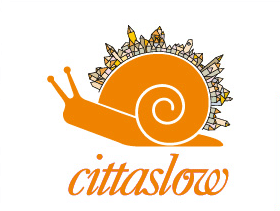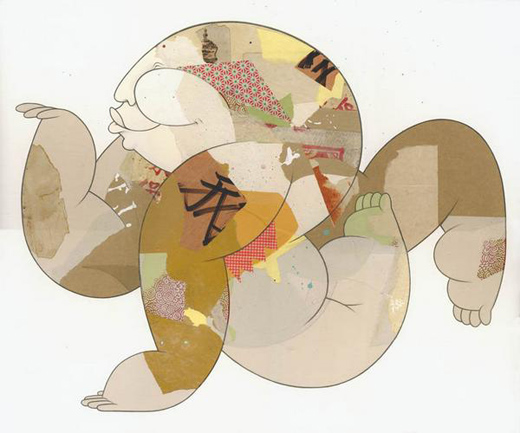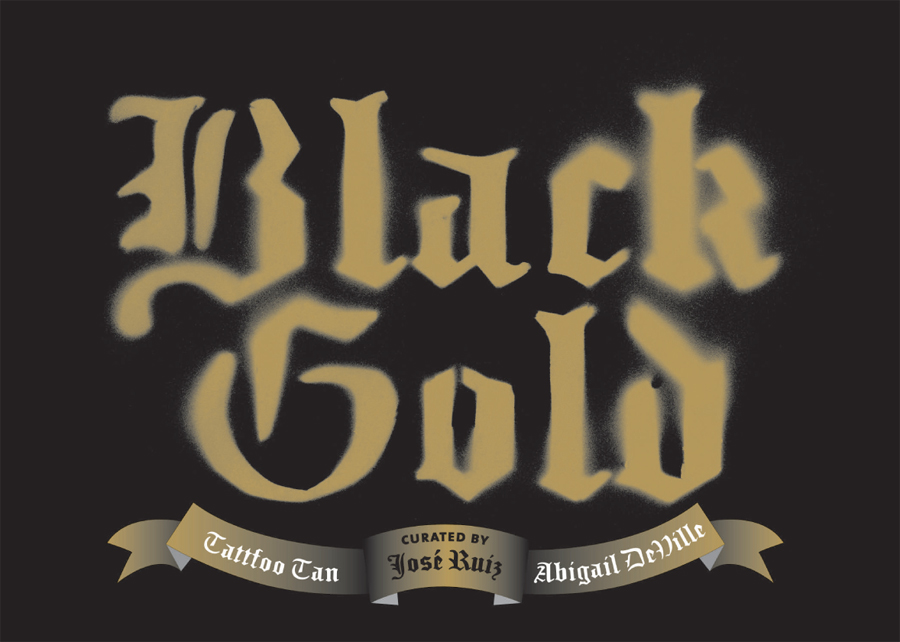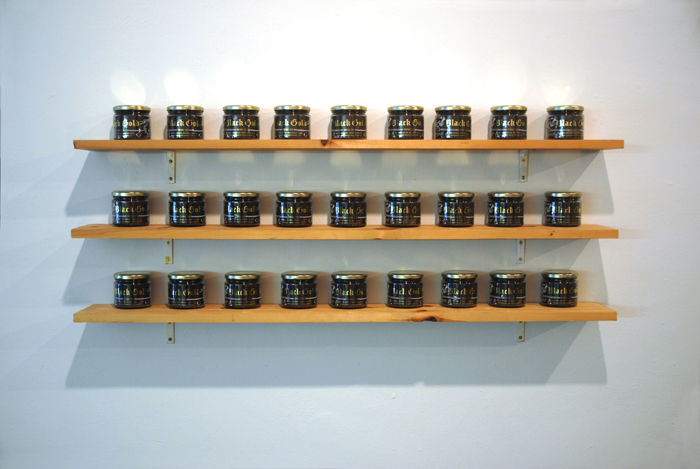DC Universe Online - Cinematic Trailer (Comic-Con ‘10)
Delete: The Virtue of Forgetting in the Digital Age
Looking for a dystopian notion for your sci-fi novel? Look no further. Mayer-Schönberger warns about the social and political costs and risks of ever-powerful, durable forms of memory prosthetics in the form of digital technologies, and proposes solutions.
http://www.amazon.com/exec/obidos/ASIN/0691138613/designobserver-20/
Chinese Designers’ Region-In Search of Identity: Chinese Design

In Search of Identity: Chinese Design
The Chinese Designers’ Region (CDR) is delighted to invite you to a roundtable discussion hosted by CDR and associate professor Dr. Wendy Siuyi Wong. Dr. Wong will give a lecture on her current research into contemporary Chinese design. To promote the discussion on the topic, CDR also invites Moa Correia who is the author of China’s Creative Voice to talk about what she has discovered about the trends of Chinese youth culture. Selected CDR members will also present their recent works. Dr. Wong who is from York University, Toronto, is currently a research fellow at Royal College of Art (RCA). The event is sponsored by Asian Design History, MA History of Design Programme at RCA.
Date: Wednesday, 11th November, 2009
Time: 6:45 pm to 9 pm
Venue: Humanities Seminar Room, Royal College of Art, Jay Mews Building
Organized by Asian Design History, MA History of Design (Royal College of Art) and Chinese Designers’ Region (CDR)
Admission: Free
Advance booking is required. Please R.S.V.P to cdrsubscription@googlemail.com. For other inquiries and information about joining CDR, please email info@cdregion.com.
Facebook: http://www.facebook.com/event.php?eid=167633363005&index=1
www.cdregion.com
www.rca.ac.uk
——————————————————————–
Program:
1. Introduction by Chinese Designers’ Region (CDR): 5 mins
2. Presentation by Dr. Wendy Siuyi Wong: 40 mins
3. China’s Creative Voice by Moa Correia: 15 mins
4. Presentations by selected CDR members: Shi Yuan (Graphic Design), Ann Xiao (Animation), Jiang Shan(Illustration) and Weiwei He (Product design). 30 mins
5. Discussion (Chaired by William Hailiang Chen)
The relationship between a designer’s ethnic background and creative work: Rethinking the current national design identity of China
by Dr. Wendy Siuyi Wong, 40 mins
This presentation will use Communication Arts, one of the oldest and foremost graphic design trade journals in the United States, with a worldwide circulation, to trace award-winning work by designers with Chinese names over the 10-year period from 1997 to 2006. The purpose of the survey is to invoke discussion of whether or not the ethnic background of each designer is reflected in his/her work, along with questions pertaining to the relationship between design and culture. Finally, this study is designed to advance the rethinking of China’s national design in the contemporary context, in light of the country’s growing exposure to influences from the rest of the world.
Dr Wendy Siuyi Wong is Associate Professor of Design at the Faculty of Fine Arts, York University, Toronto, Canada. She was the Head of Design Department from 2005-2009, and Associate Director of the York Centre for Asian Research, 2004-2009. Her research interests are in Chinese and Hong Kong visual cultural history including graphic design, comics and advertising images. She is the author of Hong Kong Comics: A History of Manhua (2002) published by Princeton Architectural Press, 4 books for Chinese readers, and numerous articles in academic and trade journals. Dr. Wong served as a visiting scholar at Harvard University from 1999 to 2000, and was the 2000 Lubalin Curatorial Fellow at the Cooper Union School of Art, New York, USA. She also curated two major exhibits on Chinese Design held at the Cooper Union School of Art (entitled Chinese Graphic Design towards the International Sphere) in 2000, and Design Exchange (entitled Chinese Design. Everyday.) in Toronto in 2008. She has taught in the United States and Hong Kong before she moved to Canada. Currently, Dr Wong serves as a visiting research fellow at the Department of History of Design, Royal College of Art.
———————————————————-
China’s Creative Voice
By Moa Correia, 15mins
Creative Voice is a new series of publications by HuntHaggarty, which focuses on trendsetting, creative youth in fast-growing, developing economies. China’s Creative Voice, the first book in the series, reveals how Chinese youth are tired of mimicking the west and Japan, and are beginning to question their identities and are developing a unique creative language. The study provides inspiring insight, not only for global brands wanting to grow in the Chinese market, but also for those looking to learn from this remarkable group of people who are reinventing their cultural identity to shape the world’s most influential economy.
Moa Correia is brand strategy planner at HuntHaggarty and the author of China’s Creative Voice.
www.hunthaggarty.com
———————————————–
驻英华人设计师联盟(CDR)将于本月11号晚在皇家艺术学院(RCA)举办《中国设计:探寻中的定义》主题讨论会。此次讨论会由CDR与加拿大多 伦多约克大学驻皇家艺术学院的访问学者黄少仪博士(Dr. Wendy Siuyi Wong)联手策划。黄少仪博士会在讨论中带来她最新的研究课题——中国当代设计;来自伦敦独立创意公司HuntHuggarty的Moa Correia也会携其著作《中国创意之声》为大家介绍她对中国青年文化及市场的最新发现和体会。除此之外,现场还会有CDR设计师的最新作品展示及演 讲。此次活动由皇家艺术学院亚洲设计史系提供场地赞助。
James Jean: RIFT
Nike Sportswear x Fader: Pitch Perfect Mixtape
As part one of Nike Sportswear and The FADER’s Pitch Perfect program, we will be posting six mixtapes featuring music from six continents (sorry, Antarctica). Each mixtape will include brand new artwork by Siggi Eggertsson, eventually available as limited edition screen-printed posters. Stay tuned for mixtapes from Europe, North America, Asia, Australia and Africa over the next two weeks.
South America is a land of beautiful extremes. It’s home to the highest waterfall, largest river, longest mountain range, driest desert and biggest rainforest on planet Earth. It is also home to some of the world’s fastest feet and broadest smiles, no doubt inspired by the music emanating from seemingly every square inch of its geography. As a member of DJ/production collective Dutty Artz, Maga Bo has taken it upon himself to see as much of this continent as possible, starting with his homebase of Rio de Janeiro, Brasil. His travels have taken him not only around South America but every continent in the world, usually returning with a hard drive full of new collaborations and productions. His Pitch Perfect South America mixtape barely scratches the surface of all that this continent has to offer, but its an impressive start with jams from Guyana to Argentina, Brazil to Colombia. Take a listen and see how long you can sit still.
Read more: http://www.thefader.com/tag/pitch-perfect-mixtape/#ixzz0uyO9htz7
YouTube Play
Flying Lotus - MmmHmm music video (taken from Cosmogramma)
The Social Network Official Trailer
Video Games And The Philosophy Of Art
 The film critic Roger Ebert’s recent comments about video games and their potential as art, and especially the immense stir the comments caused on discussion forums all over the internet, shows the intrinsic interest there is in the question of whether video games are art. Of course, many people see the debate as entirely pointless, and there is the separate question of why we should want to establish that video games are art.
The film critic Roger Ebert’s recent comments about video games and their potential as art, and especially the immense stir the comments caused on discussion forums all over the internet, shows the intrinsic interest there is in the question of whether video games are art. Of course, many people see the debate as entirely pointless, and there is the separate question of why we should want to establish that video games are art.
But the question remains, and it is entirely sensible: are video games art?
http://www.kotaku.com.au/2010/04/video-games-and-the-philosophy-of-art/
BP Photoshop disaster

This week it came to light that BP had photoshopped—poorly—an official image of their crisis command center. Apparently, that wasn’t an isolated incident. Let’s take a closer look at this view from a helicopter, shall we?
The photo, sent in by a tipster and entitled “View of the MC 252 site from the cockpit of a PHI S-92 helicopter 26 June 2010,” shows up here, a section of BP’s website that hopes to explain their response effort through pictures. This one, sadly, is fabricated.
The first thing you might notice out of place is the looming air traffic control tower in the upper left hand side of the photo:

Then, direct your attention to where the water abruptly changes shades of blue in a frenzy of pixelation, blurring, and a disappearing vessel:

Zeroing in on the pilot on the left, evidence of a pretty sloppy cutting job:

And last, while the helicopter clearly appears to be situated at some height above the boats ahead, the readouts on the dash appear to indicate that that door and ramp are open and the parking brake engaged, not to mention that the pilot appears to be holding a pre-flight checklist:

And so on. As one reader pointed out, the tower may in fact be an oil rig adjacent to a helipad (which would also explain why the pilots are in prep mode), but the photo’s still clearly been doctored. Badly.
Obviously there are bigger fish to fry when it comes to BP. But every time they fabricate an image like this, it undermines whatever little credibility they have left, along with all of the actual documentation of the massive undertaking this has been and will continue to be. It speaks to a company still more concerned with image than reality, in charge of repairing something so terribly broken that we can’t afford to treat it with anything but total candor. [BP]
http://gizmodo.com/5592836/bp-photoshops-another-official-image-again-terribly
Cittaslow
Cittaslow (literally Slow City) is a movement founded in Italy in October of 1999. The inspiration of Cittaslow was the Slow Food organization. Cittaslow’s goals include improving the quality of life in towns while resisting “the fast-lane, homogenized world so often seen in other cities throughout the world” — as the official slowmovement.com description puts it. Celebrating and supporting diversity of culture and the specialties of a town and its hinterland are core Cittaslow values.
Cittaslow is part of a cultural trend known as the Slow movement.
There are 50 goals and principles that each Cittaslow town commits to work to achieve. Although there will always be place for improvement these goals serve as tangible benchmarks to improve the quality of life in the city.[2].
The main aims of the movement are:
- making life better for everyone living in an urban environment
- improving the quality of life in the cities
- resisting the homogenization and globalization of towns around the globe
- protecting the environment
- promoting cultural diversity and uniqueness of individual cities
- provide inspiration for a healthier lifestyle
“Cittaslow is about more than a set of 50 goals and principles. It is a way of thinking. It is about caring for your town and the people who live and work in it or visit it. It is about celebrating and promoting diversity and avoiding the ‘sameness’ that afflicts too many towns in the modern world. It is about finding a place in a changing world where values are often uncertain and the needs and aspirations of local communities can often be overlooked.”[3]
News of Future
September 26, 2040 - Hurry up if you still have euro banknotes lying around in your drawers, Friday is the last day for you to cash them in. Officials said yesterday that they are very pleased with the transition in removing the banknotes and coins from the market.Due to the lack of demand for cash and the development of smartcards, the decision was taken five years ago to remove all euro banknotes and coins from the market. The major information campaigns and exposure in the media has given a great result, collecting more than 99,96% of the cash in circulation.
The euro was established as a unit of exchange in 1999 by 12 European Union member states and entered circulation in 2002. After only 38 years on the market you will in the future only be able to see them in a museum.
Argument: Bank of England cut the number of banknotes issued by 25 per cent between year 2001 and 2005. Due to the increase of e-commerce and the development of smartcards, the need for cash will continue to decrease, and finally be removed in year 2040.
Questions: What complications might occur if you remove banknotes and coins from a market? What necessary steps have to be taken to make it possible to take them out of circulation?
Submit your prediction.
http://www.newsoffuture.com/
Plump tattooed forms by Peter Taylor
Peter Taylor is a painter and illustrator from Vancouver, Canada, known for his plump tattooed forms. With a background in graffiti, Taylor has continued to work in large scale. His technique with acrylic airbrush is very similar to that of spraypaint, and the large scale allows him to retain many of his approaches to paint handling and layout, but to increase the level of detail to a large degree.
Applied to the relatively simplistic and repeating character shapes, Taylor’s paintings evoke a sense of balance and complexity, contemplation and playfulness.
http://koikoikoi.com/2010/06/plump-tattooed-forms-by-peter-taylor/
Showcase Of Web Design In China: From Imitation To Innovation
When asked, “Can the world learn anything from Chinese web design?” Lytous Zhou answered without hesitation: “Culture. The Chinese respect Dao, and we have our own set of values and mores. Websites targeted to the Chinese market should follow the online habits and aesthetics of Chinese users. For example, cultural symbols, calligraphic elements and festivities: all of these could be integrated into a Web design if applicable. A lake may just be a lake, but associating a fairy tale with a lake makes it prettier.”
http://www.smashingmagazine.com/2010/03/15/showcase-of-web-design-in-china-from-imitation-to-innovation-and-user-centered-design/
Phonetikana

Multiple trips to Japan and constant frustration at being unable to read the language has sparked off an unusual typographic project at johnson banks. Earlier in the year we started seeing if we could combine the English language and Japanese script in some way.
http://www.johnsonbanks.co.uk/thoughtfortheweek/index.php?thoughtid=501
Inspiration Pad
Brand New Conference
A one-day event organized by UnderConsideration on the development of corporate and brand identity projects by some of today’s most active and influential practitioners from around the world.
with
Michael Johnson
JOHNSON BANKS
London
Michael Lejeune
METRO DESIGN STUDIO
Los Angeles
Michael Bierut and Paula Scher
PENTAGRAM
New York
Christian Helms
THE DECODER RING DESIGN CONCERN
Austin
Tom Dorresteijn
STUDIO DUMBAR
Rotterdam
Connie Birdsall
LIPPINCOTT
New York
Jordan Crane and Karl Heiselman
WOLFF OLINS
New York
Erik Spiekermann
EDENSPIEKERMANN AG
Amsterdam, Berlin, Stuttgart
Teaching in a Time of Uncertainty
Meditation on the doubt creeping into today’s design practice.
By Constantin Boym

Postcard image by Ken Brown.
Since the beginning of professional industrial design — throughout the entire 20th century and into the first decade of the 21st — a designer has been a figure of confidence and authority. He (rarely, she) provided answers, solved problems, knew more than the public could possibly knew. A notion of an unsure designer, a questioning designer, or, heaven forbid, a doubtful designer would appear almost oxymoronic, and certainly unprofessional.
Perhaps the new decade will go down in history as marking the outset of Design Uncertainty. For the first time ever, designers are willing to question, openly and publicly, the nature of their profession and whether they are doing the right thing. This year, for the first time, an interrogation mark appeared in the title of the National Design Triennial at the Cooper-Hewitt. In the Netherlands, Eindhoven Design Academy’s 2010 exhibition in Milan expressed the same spirit of inquiry with an even more succinct title, a simple “?”
The reasons for self-searching and doubt are obvious, and they are not pretty. Two seemingly never-ending wars have contributed to political uncertainty and fueled fears of terrorism. The economic meltdown of 2008 continues to reverberate around the world. An unimpeded flood of oil gushes out in the Gulf of Mexico, in spite of the feats of the world’s best experts to stop it. Alice Rawsthorn, writing in The New York Times, recently captured the spirit of our time when she referred to design as “a quest for meaning in a dystopian era.” This existential mission, rather than a pursuit of new shapes, is going to define the design effort for years to come. And any search for meaning always starts with a question.
Clive Dilnot, a professor at The New School University, writes in an essay titled “Ethics? Design?” that the basis of any design activity derives from a fundamental query posed by Socrates: “How should one live?” According to Dilnot, this question cannot lead to a singular answer. Rather, the argument is brought up again and again by every new generation, leaving the ethical dimension of design “always in question, always in doubt.”
It is not surprising that the best design schools are in the forefront of design’s quest for meaning. Unencumbered by market considerations, academia is well suited for experimentation, creative research and the production of ideas. It is good to be a student in times like these. But what about the teachers? The traditional role of all-knowing professor is rapidly changing. Instead, a teacher has become a fellow researcher, a team leader who works with the group in an interactive, collaborative way. The result is inevitably interdisciplinary: a design “product” could be an idea, a service, a material or a narrative, and it is viewed as a process rather than an artifact.
With these thoughts I start a new chapter in my professional life. Recently, I have become director of graduate design studies at the Virginia Commonwealth University in Qatar. All complexities and contradictions on the modern world are reflected in the microcosm of this Persian Gulf state: East and West, old and new, national and global, rich and poor. This is a world in transition, full of its own uncertainties. As such, it should be a great testing ground for new ideas and new solutions. A small group of young men and women from different design backgrounds are joining our program, the first of its kind in the entire Gulf Region. Let the experiment begin. Together, we will be trying to work out our own answers to that nagging question, Why Design Now?
via http://changeobserver.designobserver.com/entry.html?entry=14378
Joel Evey: Nu Memphis
A mini sketchbook of thoughts / explorations on an emerging movement I see manifesting in the current visual culture of internet design, that for lack of a better term I’m calling “Nu Memphis”.
Tattfoo: Black Gold


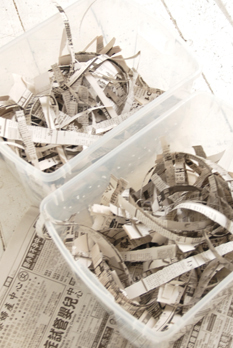
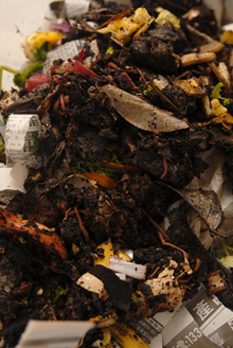
| 1. Drill some holes into a used plastic tote. The worms need to breath. | 2. Shred newspaper. | 3. Add worms into it new home. They are red wigglers (Eisenia Fetida). |
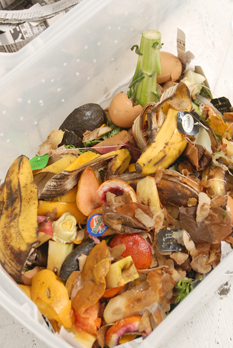
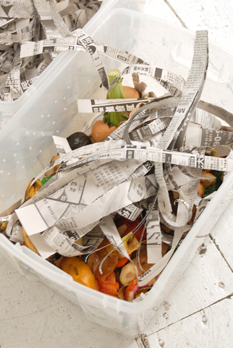

| 4. Add organic food scraps, but no meat and dairy products. |
5. Add more newspaper or water to make the entire content moist but not flooded. |
6. Store in a dark place. Worms love to work in dark environment. |
Black Gold took the concept of Piero Manzoni into the 21st century by canning worm casting instead of artist’s waste. By purchasing this artwork one is confronted the dilemma of using the compost as a plant fertilizer or not using it and maintain it status as a work of art? Piero also price his work weight based on the current value of gold (around $1.12 a gram in 1960) and coincidentally, compost is called Black Gold by gardener because of its value in improving garden soil.
In a undisclose location, a secret cellar is in the process of brewing the most creative compost ever. The curing process will take a year long but the final results in pure gold. Black gold to be more precise. The special blended concoction is under the skillful hand and eyes of Master Composter Tattfoo. This limited edition 2009 vintage will be availble in early spring 2010. Reserve your bottle now.

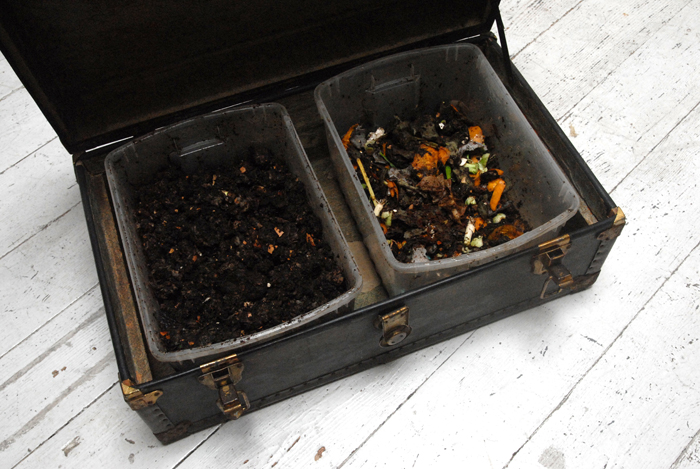
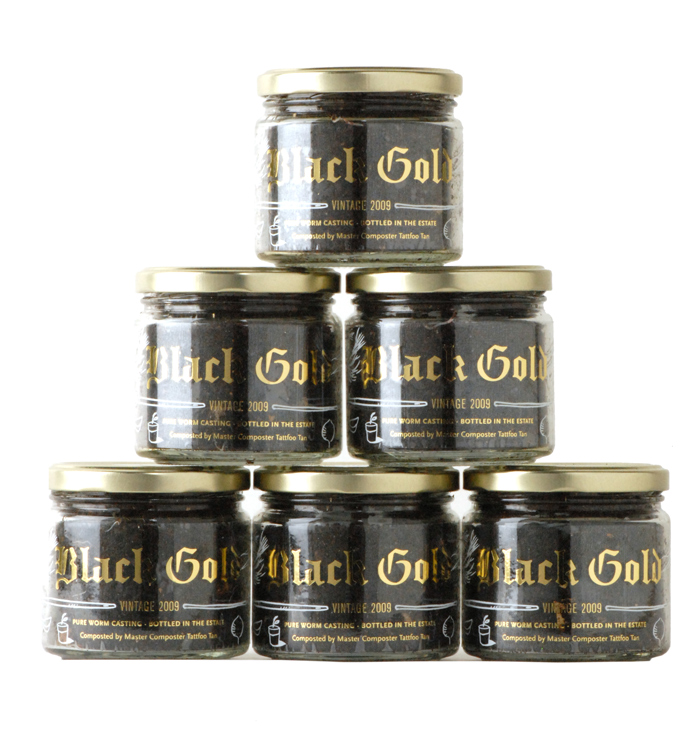
The current value of gold is USD900 per oz. and each botlle contain 10oz of Black Gold. The price of each bottle is USD9000. Email me for a special recession price.
Sowing the seed in Bronx, New York at Bronx River Art Center
BRONX RIVER ART CENTER opens curatorial initiative DIALECTS and its inaugural exhibition, Black Gold, featuring Tattfoo Tan (Gallery 1) & Abigail DeVille (Gallery 2)—opening on Friday, July 24, 2009 from 6 - 9pm.
Bronx, NY, July 1, 2009…. The Bronx River Art Center (BRAC) is pleased to open its 2009-10 gallery season with a new curatorial initiative entitled DIALECTS. Working under the umbrella of local and international dialogue, research, and collaboration, DIALECTS presents 4 sets of side-by-side solo exhibitions, 8 exhibitions total, that pair local Bronx artists with foreign-born, NY-based artists. The exhibitions will showcase the new work created from this process and will be overseen by BRAC’s Gallery Director & Curator José Ruiz.
Bronx artists Blanka Amezkua (Mixed-media), Vidal Centeno (Sculpture & Installation), Abigail DeVille (Painting), and Ronny Quevedo (Printmaking) will pair up with artists Shelly Bahl (India/Canada), Tattfoo Tan (Malaysia), Bjargey Olafsdottir (Iceland), and Dario Solman (Croatia). In order to further the definition of the “international” and “New York” artist, while simultaneously bridging cultures and ideologies, BRAC has invited artists who hail from countries that are currently underrepresented in the global art scene as a parallel response to the Bronx’s own position within the New York art community.
Black Gold, the first exhibition in the series, extrapolates context from a term that carries diverse meanings and connotations. From glorified connections to oil drilling, to re-branded forms of jewelry, and even political forms of corruption, this ominous term allows Malaysian-born artist Tattfoo Tan and Bronx artist Abigail DeVille to bilaterally coalesce around themes of urbanity & nature, decay & environmental stewardship, and loss & congregation, to name a few. The exhibition, which features new, site-specific works in painting, sculpture, and installation, amidst subtle interventions and collaborations within each of the artists’ projects, will run from Friday, July 24 to Saturday, September 12, 2009.
In Gallery 1: Tattfoo Tan’s art practice encompasses a wide set of mediums, such as sculpture, installation, design, and public
artworks, to establish an interactive and often participatory relationship with the viewer. Influenced primarily by a need to
decipher the crux between art and life, the artist gives life to his works through a framework of collaborative events, dinners,
exchanges, and eclectic everyday rituals. The artist uses organic, living materials as transitional elements that live, grow, die, decompose, and through his interventions, are repositioned at the same hierarchical level and with the same innate complexities as the viewer. It is within this milieu of shared relational systems that Tattfoo’s work becomes conscious. In keeping with the spirit of the transitional, his works are often ephemeral and conceptual in nature. His most recent body of work, S.O.S. (Sustainable. Organics. Stewardship.) is a multifaceted, yearlong horticulture and cultivation project, in which the artist engages deeply in the social and cultural curve of “green” ethics and aesthetics. By acknowledging the shortage of food at the global scale—how we eat, what we eat and how we should offset these demands—the artist tackles the sociopolitical ramifications of the origin of food, its labor, and their direct effect on our health and well-being with humorous works and challenging interventions inside and outside of BRAC.
In Gallery 2: Abigail DeVille presents a new, site-specific installation that combines painting, drawing, and collage to create a
wild, chaotic, and seductive environment encompassing the gallery’s walls, floor, and ceiling. This large-scale work physically mixes and juxtaposes old and new paintings and sculptural elements as installation materials and objects for a topographical assemblage. A part of her ongoing series Universal Diagrams of Discourse, this work uses the pictorial format to highlight issues and concerns in contemporary history and American society. In mathematical theory, the Universe of Discourse includes all things that are under discussion at a given time. Extrapolating from this idea, DeVille manifests the complexity of “blackness” and the reality of racial prejudice and tension in America within a sociological Venn diagram: a rectangle comprised of an infinite variety of situations, narratives, and multiple points of view. The artist balances and counterweighs the overabundance of rough, toxic and inauthentic societal visions with poetic resistance and self-reflection. These excesses are illuminated with an excessive artistic process that is layered, dense, and loaded with diverse sets of response imagery and codes of influence, from African sculpture and textiles to the artist’s own personal biography. This compositional whirlwind and structured disarray outlines the confusion of the individual in American society, the decay of social structures throughout America’s cities, and glorifies the richness of popular, intellectual, and artistic culture that has been born from this maelstrom.
ABOUT THE ARTISTS:
Tattfoo Tan was born in Malaysia and currently resides in Staten Island, NY. He has exhibited extensively over the past decade at venues such as the Queens Museum of Art, Pocket Utopia, Lower East Side Tenement Museum, Jamaica Center for Arts & Learning, and Flux Factory, all in New York. Tan has participated in residencies and fellowships at the Center for Book Arts (NY) and at Aljira, a Center for Contemporary Art (NJ) as well as lectured at institutions such as the Fashion Institute of Technology (NY) and the California Institute of the Arts (CA). He has created public works in partnership with the Lower Manhattan Cultural Council, Fashion Center Business Improvement District, Times Square Alliance, DUMBO Improvement District, and the NYC Department of Transportation, all in New York.
Abigail DeVille was born in New York City in 1981. She received her BFA from the Fashion Institute of Technology in 2007. In 2005, she received The Frank Shapiro award, which is F.I.T.’s highest award for excellence in Fine Arts. She received a fellowship to participate in the Skowhegan Residency Program in 2007 and was a participant in the artworld’s first reality show, Artstar, which aired on Gallery HD from June 2006 – January 2009 and culminated with an exhibition at Deitch Projects (NY). Currently, DeVille is a Resident Artist and Art Instructor at the Bronx River Art Center. A longtime resident of the Bronx, Abigail DeVille will begin her graduate studies at Yale University’s prestigious Painting Program this fall.
Bronx River Art Center 1087 East Tremont Ave Bronx, NY 10460 718.589.5819 www.bronxriverart.org
The Bronx River Art Center (BRAC) is a culturally diverse, multi-arts, non-profit organization that provides a forum for community,
artists and youth to transform creativity into vision. Our Education, Exhibitions, Artist Studios, and Presenting programs cultivate
leadership in an urban environment and stewardship of our natural resource—the Bronx River.
GALLERY HOURS Monday–Friday 2pm–6pm / Saturday 12pm–5pm ADMISSION Free
These exhibitions are made possible with support from the New York State Council on the Arts, a state agency. Additional support is provided by the New York City Department of Cultural Affairs and the Deutsche Bank Americas Foundation’s Arts & Enterprise Place-Based Revitalization Program. Tattfoo Tan’s project is made possible, in part, by a New York State Council on the Arts’ Original Work Grant in partnership with the Council on the Arts and Humanities of Staten Island.
PRESS:
Irrelevant
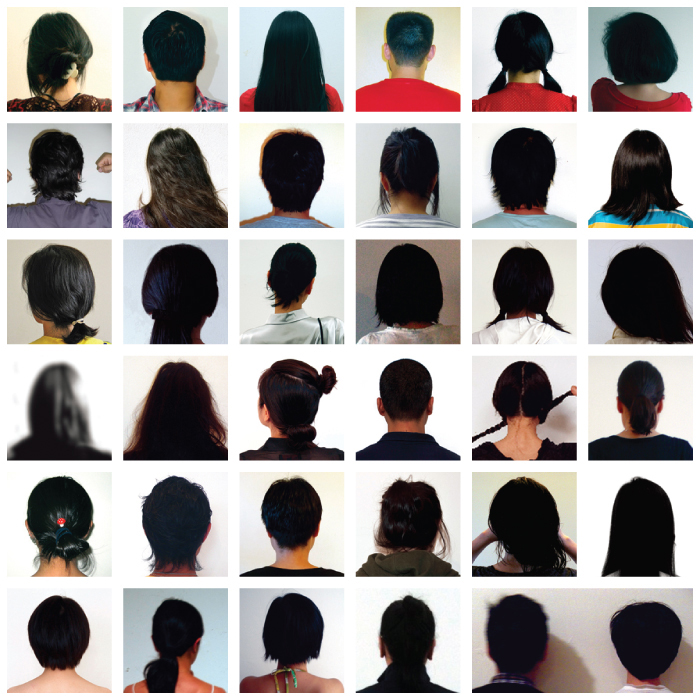

http://tattfoo.com/SOSGreenStewardship.html
Arario Gallery is very proud to present Irrelevant: Local Emerging Asian Artists Who Don’t Make Work About Being Asian, an ambitious survey exhibition featuring the work of nearly fifty artists curated by Joann Kim and Lesley Sheng.
Irrelevant wishes to highlight artists who are more American than Asian, based in New York, and embedded in an expansive community of emerging artists struggling to show and succeed in this cutthroat city. You will not find paintings about the Cultural Revolution or Mao Zedong that sell for hundreds of thousands of dollars. You will not find manga-infused characters performing acts of hypersexuality nor will you find decorative miniature drawings with motifs embedded within a specific cultural history.
What you’ll find is a surging flow of creativity where artists actively engage in their practice, exploring the absurd within everyday experience, the use and misuse of materials both new and found, and the curiosity of defining artistic practice. Food and consumption is considered within an urban agricultural environment, and social interaction is taken out of norm and reenacted in refreshing alternative ways. Pictured narratives gear toward a dark and isolated realm and obsession is the source behind abstracted images.
A major focus of this exhibition is to formulate a community, building a foundation for artists to gather and exchange ideas and experiences. There is an endless array of amazing underrepresented artists in NY, thriving yet unheard. Through this exhibition we get to see artists engaging with their given role and their interests within a particular medium, exploring on both conceptual and idealistic levels with painting, photography, performance, sculpture and installation. We get to see abstraction within the everyday and the everyday within abstraction. We get to see materials unfolded, manipulated, reworked and dysfunctioned. We get to feel self-conscious and hyper aware of our stance as viewers, where time and space is altered and questioned.
Irrelevant is a friendly and humorous, and somewhat ridiculous, rejection of a neurotic art market and its obsession with specifying artists to a particular culture and ethnicity. This exhibition purifies and de-labels the artist as Asian, by labeling the artist as Asian, to be shown inside a contemporary Asian art gallery.
Artists:
Seong Min Ahn, Shin Young An, Sophia Chai, Louis Chan, Karen Chan, Rona Chang, Gigi Chen, Yoon Cho, Micah Ganske, Hyoungsun Ha, Geujin Han, Takashi Horisaki, Jane V. Hsu, Hidenori Ishii, Hong Seon Jang, Kyoung Eun Kang, Heige Kim, Seung Ae Kim, Nancy Kim, Hein Koh, Shizuka Kusayanagi, Amy Fung-yi Lee & Caroline Jung-ah Park, JaeEun Lee, Sinae Lee, Soo Im Lee, Jiyoun Lee-Lodge, Pixy Liao, Juri Morioka, Tadashi Moriyama, Joel Morrison, Dominic Neitz, Christian Nguyen, Asuka Osawa, Eung Ho Park, Youngna Park, Jung Eun Park, R&D, Ruijun Shen, Satomi Shirai, Hidemi Takagi, Tattfoo Tan, Kikuko Tanaka, Jason Tomme, Mai Ueda, Kako Ueda, InJoo Whang, Mika Yokobori, Yejin Yoo, Jayoung Yoon, Seldon Yuan
Mark Essen: NIDHOGG
The Creators Project by Intel x Vice
The Creators Project is a new network dedicated to the celebration of creativity and culture across media, and around the world.
Old Spice Channel
http://www.youtube.com/user/oldspice#p/u/0/dfqlVi5DGuo
Old Spice Man responses to tweets and comments randomly
Copyright © _dreams. All rights reserved.



